Reducing Hand Kinematics by Introducing Grasp-Oriented Intra-Finger Dependencies
Abstract
1. Introduction
- We introduced refined procedures for data wrangling, generating a meticulously curated dataset for the comprehensive modeling and analysis of human hand movements.
- Our novel approach to modeling intra-finger dependency-movement relationships enabled the establishment of motion patterns for each dependency across all subjects. It generated interpretable and sparse, yet accurate, integrated models. Additionally, it significantly reduced the total number of DOFs involved in grasping for all investigated functional movements.
- Applying hierarchical model clustering enabled flexibility in reducing the number of models capable of describing all 116 identified dependencies with a desired error margin. Based on the similarity in coefficients, we proposed 30 such model clusters.
2. Materials and Methods
2.1. Data Relabeling
- 8 isometric and isotonic hand configurations;
- 9 basic movements of the wrist.
- 23 grasping and functional movements (everyday objects).
2.2. Data Preprocessing
“DIP sensors provide reliable angles when a subject’s hand size is large (i.e., when the glove properly fits the hand). They may provide partial results when the hand of the subject is small. Therefore, attention needs to be taken when using the information.”
- If the sample size is too small (n < 100), fill with NA values;
- If a too-small part of the entire motion is captured (), fill with NA values.
2.3. Data Analysis and Sampling
- Repetitions with too-small ROM, compared to median dependency-movement, are discarded: ;
- Newly generated outlier values are removed using the iterative 1.5 IQR rule based on correlation coefficients.
2.4. Machine Learning-Based Intra-Finger Dependency-Movement Relationship Modeling
- A vector of fold IDs is generated for each relationship, containing repeating sequences in the 1–5 range, with a length equal to the number of repetitions.
- The vector of subjects is randomly shuffled, followed by the random shuffling of repetitions belonging to each subject, resulting in a random list of repetitions.
- Randomly listed repetitions are assigned to folds sequentially.
- Primary criteria: selecting a model with similar coefficient values consistently occurring across different runs,
- Secondary criteria: selecting a model with the lowest error metrics (as described in the Results and Discussion sections).
- <0.5 indicate poor reliability,
- 0.5–0.75 indicate moderate reliability,
- 0.75–0.9 indicate good reliability,
- >0.9 indicate excellent reliability.
2.5. Error Metrics
3. Results
3.1. Random and Fixed Effect Predictors
- polynomial and exponential transformation of height (poly:height_exp),
- polynomial and exponential transformation of weight (poly:weight_exp),
- exponential and exponential transformation of height (exp:height_exp),
- linear and polynomial transformation of height (lin:height_poly),
- exponential and exponential transformation of weight (exp:weight_exp).
3.2. Model Error Metric Analysis
3.3. Clustering Based on Model Coefficient Analysis
4. Discussion
Supplementary Materials
Author Contributions
Funding
Institutional Review Board Statement
Informed Consent Statement
Data Availability Statement
Acknowledgments
Conflicts of Interest
Appendix A. LME Model Coefficients’ Detailed Analysis and Model Error Metric Analyses
- Subject height or its transformed interaction with other predictors in 9/116 models,
- Transformed subject weight in interaction with other predictors in 4/116 models.



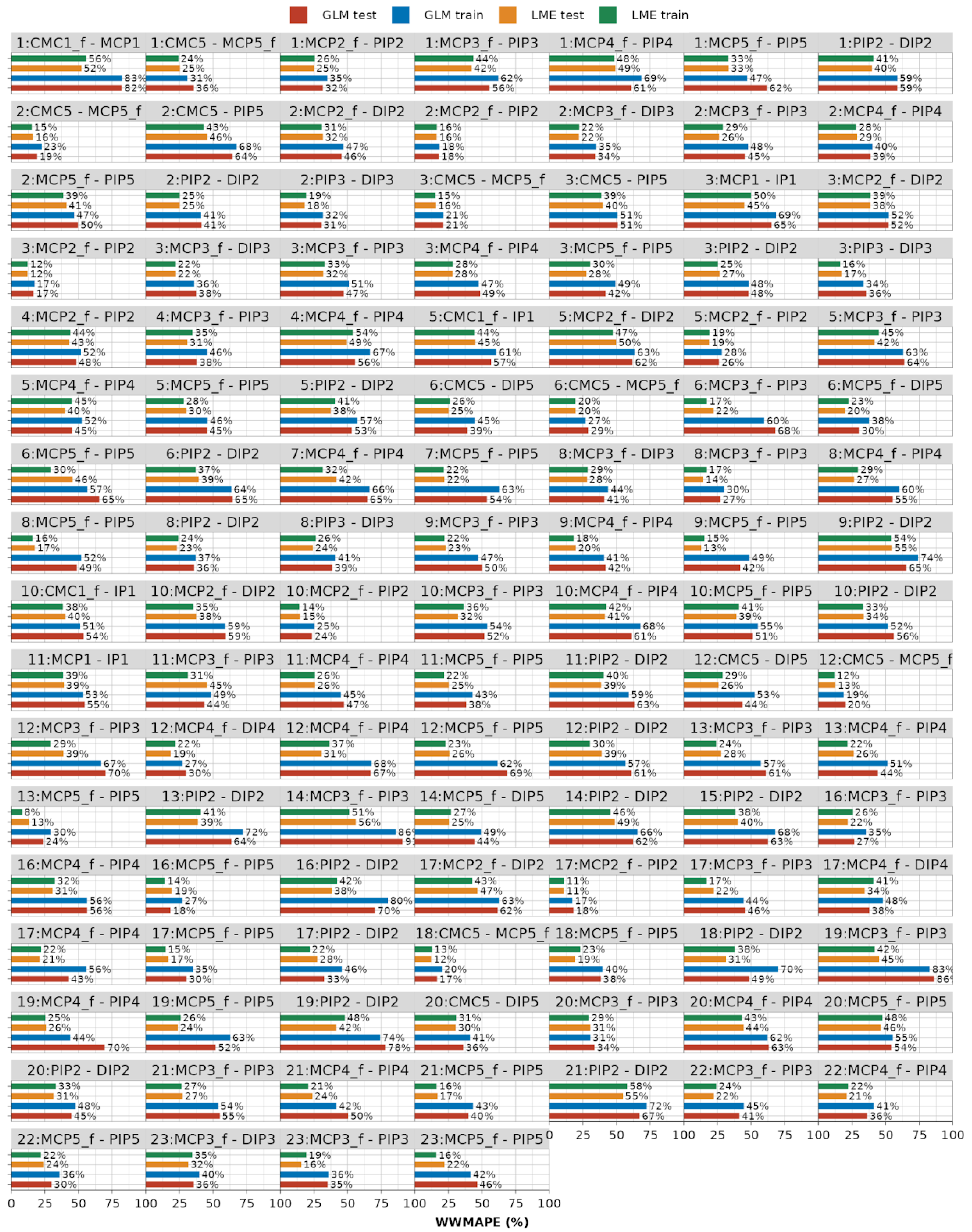
References
- Lang, C.E.; Lohse, K.R.; Birkenmeier, R.L. Dose and timing in neurorehabilitation: Prescribing motor therapy after stroke. Curr. Opin. Neurol. 2015, 28, 549–555. [Google Scholar] [CrossRef]
- Colombo, R.; Sanguineti, V. Rehabilitation Robotics: Technology and Application; Academic Press: London, UK, 2018. [Google Scholar]
- Engelhardt, L.; Melzner, M.; Havelkova, L.; Fiala, P.; Christen, P.; Dendorfer, S.; Simon, U. A new musculoskeletal AnyBody™ detailed hand model. Comput. Methods Biomech. Biomed. Engin 2020, 24, 777–787. [Google Scholar] [CrossRef] [PubMed]
- Jarque-Bou, N.J.; Atzori, M.; Müller, H. A large calibrated database of hand movements and grasps kinematics. Sci. Data 2020, 7, 12. [Google Scholar] [CrossRef] [PubMed]
- Li, R.; Wang, H.; Liu, Z. Survey on Mapping Human Hand Motion to Robotic Hands for Teleoperation. IEEE Trans. Circuits Syst. Video Technol. 2022, 32, 2647–2665. [Google Scholar] [CrossRef]
- Holzbaur, K.R.; Murray, W.M.; Delp, S.L. A model of the upper extremity for simulating musculoskeletal surgery and analyzing neuromuscular control. Ann. Biomed. Eng. 2005, 33, 829–840. [Google Scholar] [CrossRef] [PubMed]
- Ma’touq, J.; Hu, T.; Haddadin, S. A validated combined musculotendon path and muscle-joint kinematics model for the human hand. Comput. Methods Biomech. Biomed. Engin 2019, 22, 727–739. [Google Scholar] [CrossRef] [PubMed]
- Delp, S.L.; Anderson, F.C.; Arnold, A.S.; Loan, P.; Habib, A.; John, C.T.; Guendelman, E.; Thelen, D.G. OpenSim: Open-Source Software to Create and Analyze Dynamic Simulations of Movement. IEEE Trans. Biomed. Eng. 2007, 54, 1940–1950. [Google Scholar] [CrossRef] [PubMed]
- Cobos, S.; Ferre, M.; Ángel Sánchez-Urán, M.; Ortego, J.; Aracil, R. Human hand descriptions and gesture recognition for object manipulation. Comput. Method. Biomec. 2010, 13, 305–317. [Google Scholar] [CrossRef] [PubMed]
- Zhang, N.; Zhao, Y.; Gu, G.; Zhu, X. Synergistic control of soft robotic hands for human-like grasp postures. Sci. China Technol. Sci. 2022, 65, 553–568. [Google Scholar] [CrossRef]
- Kamper, D.G.; Cruz, E.G.; Siegel, M.P. Stereotypical Fingertip Trajectories During Grasp. J. Neurophysiol. 2003, 90, 3702–3710. [Google Scholar] [CrossRef]
- Jarque-Bou, N.; Gracia-Ibáñez, V.; Sancho-Bru, J.; Vergara, M.; Pérez-González, A.; Andrés, F. Using kinematic reduction for studying grasping postures. An application to power and precision grasp of cylinders. Appl. Ergon. 2016, 56, 52–61. [Google Scholar] [CrossRef] [PubMed]
- Jarque-Bou, N.J.; Vergara, M.; Sancho-Bru, J.L.; Gracia-Ibáñez, V.; Roda-Sales, A. Hand Kinematics Characterization While Performing Activities of Daily Living Through Kinematics Reduction. IEEE Trans. Neural Syst. Rehabil. Eng. 2020, 28, 1556–1565. [Google Scholar] [CrossRef] [PubMed]
- Gracia-Ibáñez, V.; Sancho-Bru, J.L.; Vergara, M.; Jarque-Bou, N.J.; Roda-Sales, A. Sharing of hand kinematic synergies across subjects in daily living activities. Sci. Rep. 2020, 10, 6116. [Google Scholar] [CrossRef] [PubMed]
- Prevete, R.; Donnarumma, F.; d’Avella, A.; Pezzulo, G. Evidence for sparse synergies in grasping actions. Sci. Rep. 2018, 8, 616. [Google Scholar] [CrossRef] [PubMed]
- Ninapro. Available online: https://ninapro.hevs.ch/ (accessed on 26 March 2024).
- Jarque-Bou, N.J.; Scano, A.; Atzori, M.; Müller, H. Kinematic synergies of hand grasps: A comprehensive study on a large publicly available dataset. J. Neuroeng. Rehabil. 2019, 16, 63. [Google Scholar] [CrossRef] [PubMed]
- Bazina, T.; Kamenar, E.; Zelenika, S.; Črnjarić-Žic, N.; Schnurrer-Luke-Vrbanić, T. Hand model with dependency constrained joints for applications in rehabilitation robotics. Med. Flum. 2022, 58, 385–398. [Google Scholar] [CrossRef]
- Tay, J.K.; Narasimhan, B.; Hastie, T. Elastic Net Regularization Paths for All Generalized Linear Models. J. Stat. Softw. 2023, 106, 1–31. [Google Scholar] [CrossRef] [PubMed]
- Wickham, H.; Averick, M.; Bryan, J.; Chang, W.; McGowan, L.D.A.; François, R.; Grolemund, G.; Hayes, A.; Henry, L.; Hester, J.; et al. Welcome to the Tidyverse. J. Open Source Softw. 2019, 4, 1686. [Google Scholar] [CrossRef]
- Luraschi, J.; Kuo, K.; Ruiz, E. Mastering Spark with R: The Complete Guide to Large-Scale Analysis and Modeling; O’Reilly Media: Newton, MA, USA, 2019. [Google Scholar]
- GitHub. Available online: https://github.com/tbazina/kinematic-database (accessed on 2 April 2024).
- Rousseeuw, P.J.; Hubert, M. Robust statistics for outlier detection. Wires Data Min. Knowl. 2011, 1, 73–79. [Google Scholar] [CrossRef]
- Mukaka, M.M. Statistics corner: A guide to appropriate use of correlation coefficient in medical research. Malawi Med. J. 2012, 24, 69–71. [Google Scholar]
- Bates, D.; Mächler, M.; Bolker, B.; Walker, S. Fitting Linear Mixed-Effects Models Using lme4. J. Stat. Softw. 2015, 67, 1–48. [Google Scholar] [CrossRef]
- Nieminen, P. Application of Standardized Regression Coefficient in Meta-Analysis. BioMedInformatics 2022, 2, 434–458. [Google Scholar] [CrossRef]
- Meteyard, L.; Davies, R.A. Best practice guidance for linear mixed-effects models in psychological science. J. Mem. Lang. 2020, 112, 104092. [Google Scholar] [CrossRef]
- Koo, T.K.; Li, M.Y. A Guideline of Selecting and Reporting Intraclass Correlation Coefficients for Reliability Research. J. Chiropr. Med. 2016, 15, 155–163. [Google Scholar] [CrossRef] [PubMed]
- Gracia-Ibáñez, V.; Vergara, M.; Buffi, J.H.; Murray, W.M.; Sancho-Bru, J.L. Across-subject calibration of an instrumented glove to measure hand movement for clinical purposes. Comput. Methods Biomech. Biomed. Eng. 2016, 20, 587–597. [Google Scholar] [CrossRef]
- Laffranchi, M.; Boccardo, N.; Traverso, S.; Lombardi, L.; Canepa, M.; Lince, A.; Semprini, M.; Saglia, J.A.; Naceri, A.; Sacchetti, R.; et al. The Hannes hand prosthesis replicates the key biological properties of the human hand. Sci. Robot. 2020, 5, eabb0467. [Google Scholar] [CrossRef]
- Alicea, R.; Xiloyannis, M.; Chiaradia, D.; Barsotti, M.; Frisoli, A.; Masia, L. A soft, synergy-based robotic glove for grasping assistance. Wearable Technol. 2021, 2, e4. [Google Scholar] [CrossRef]
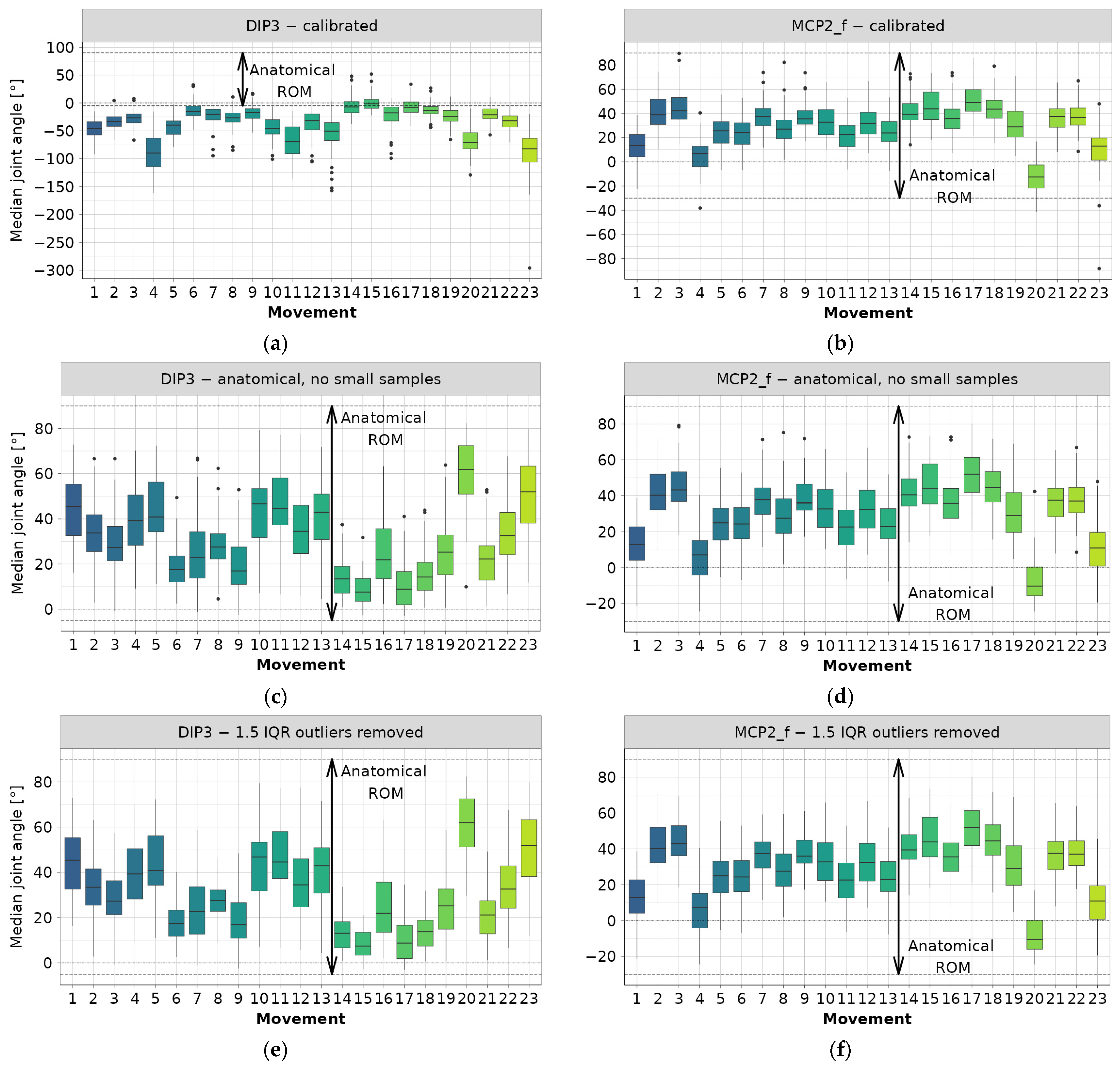


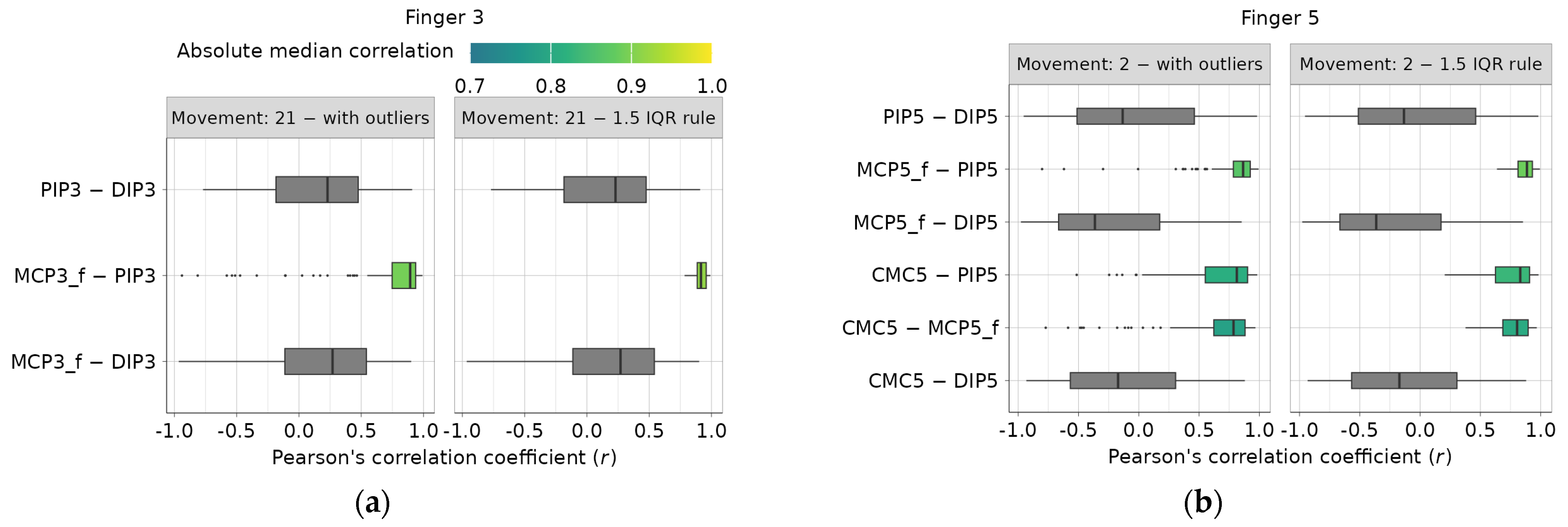


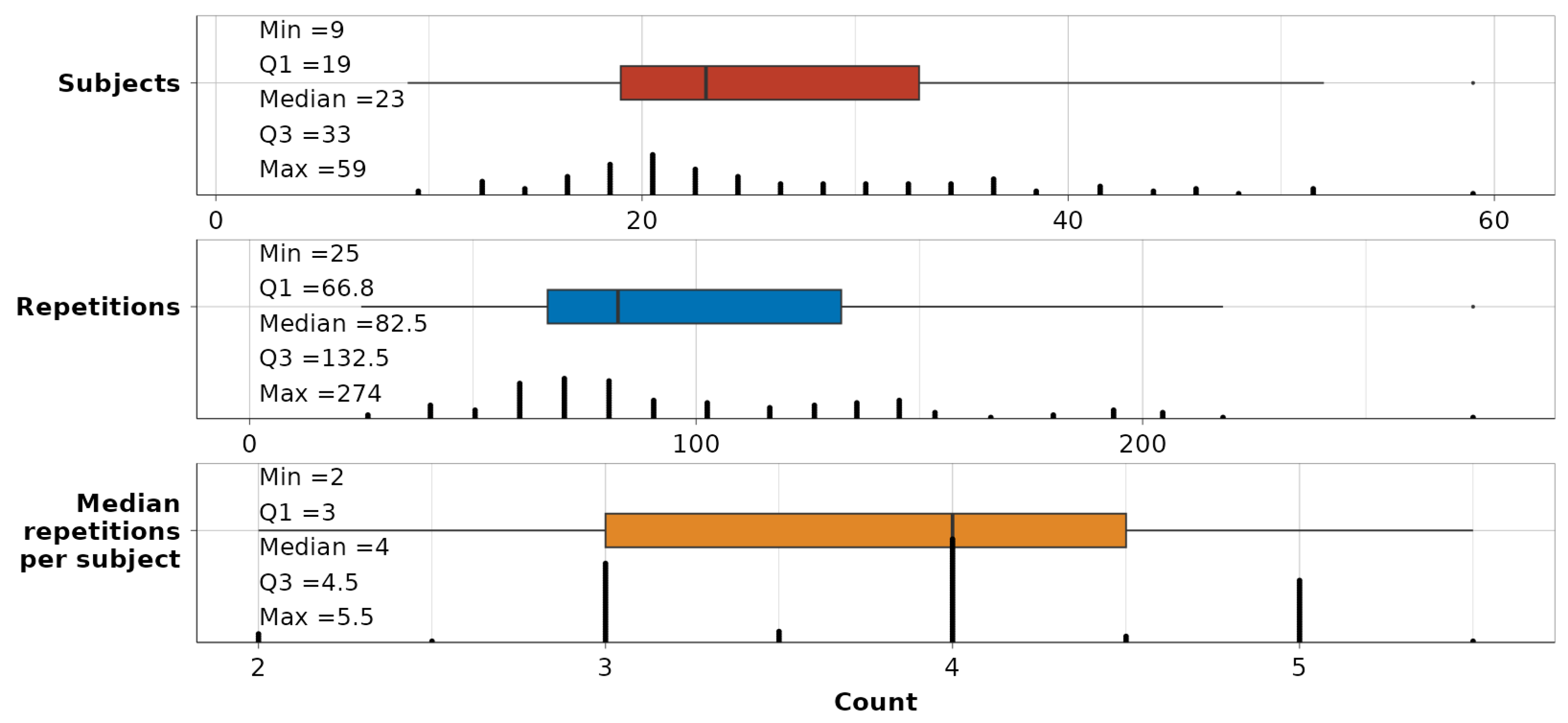
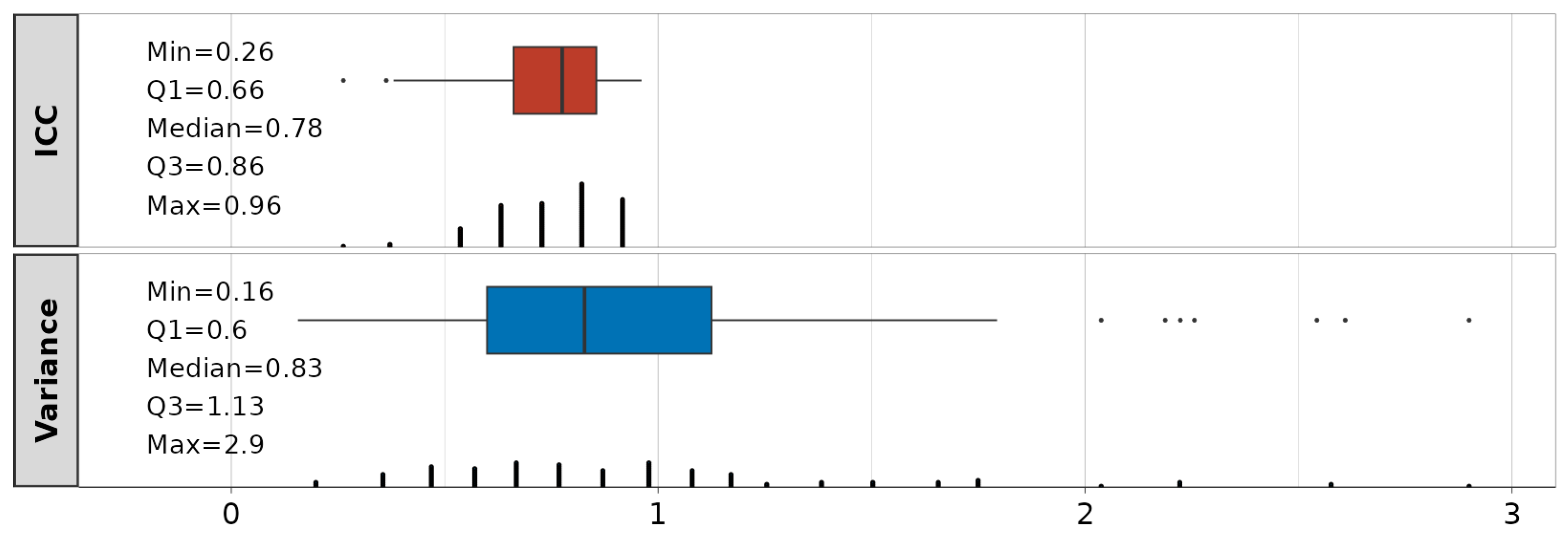

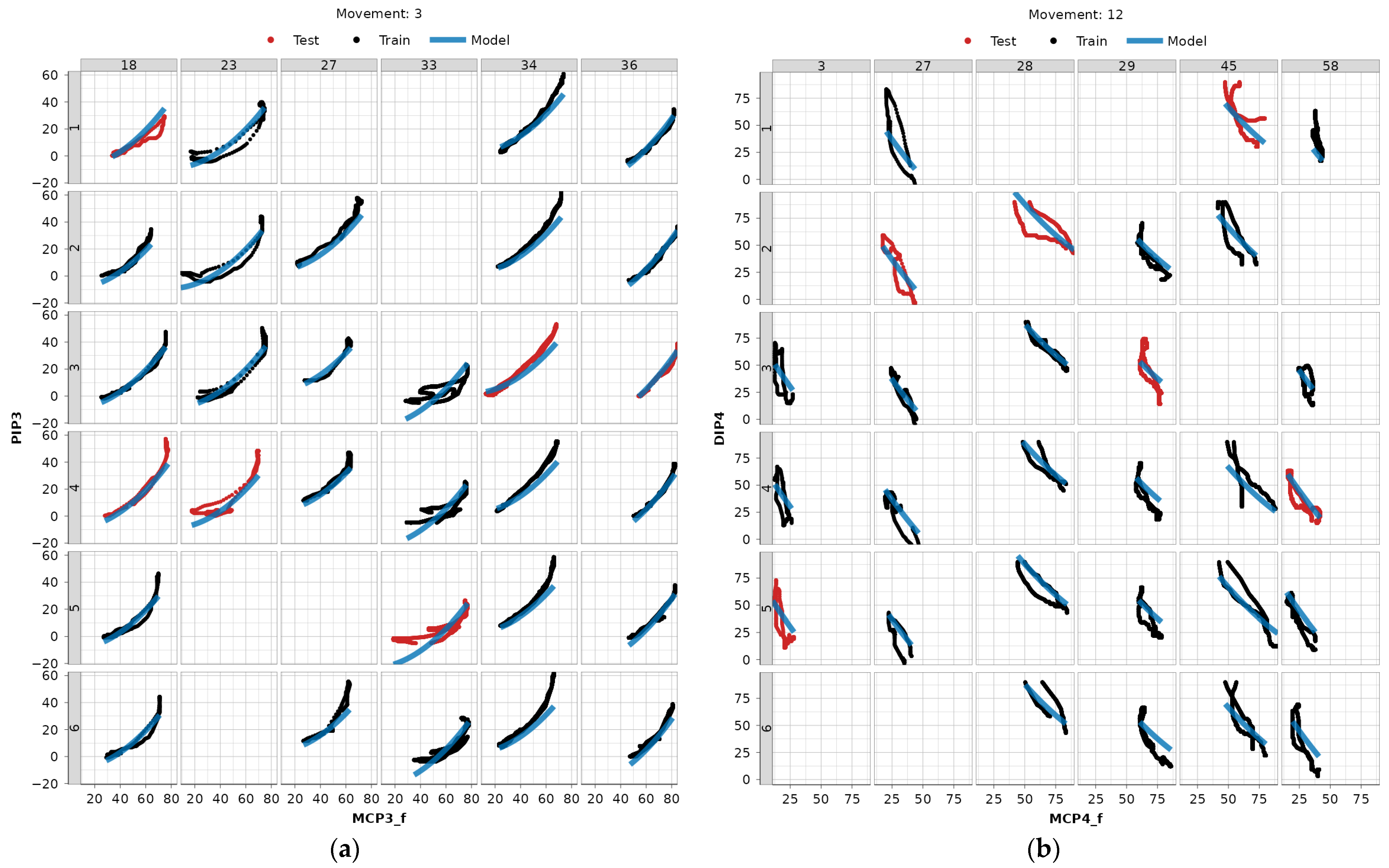
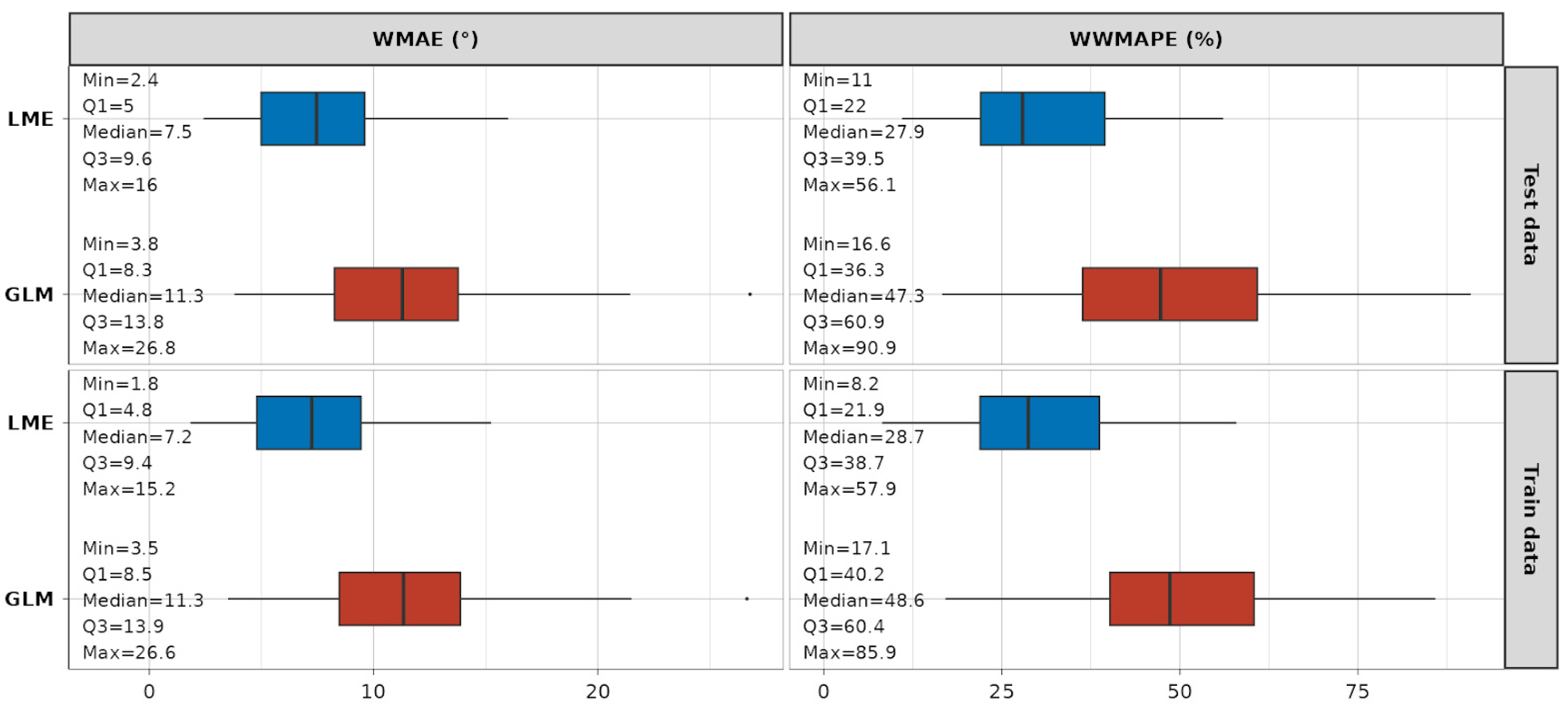
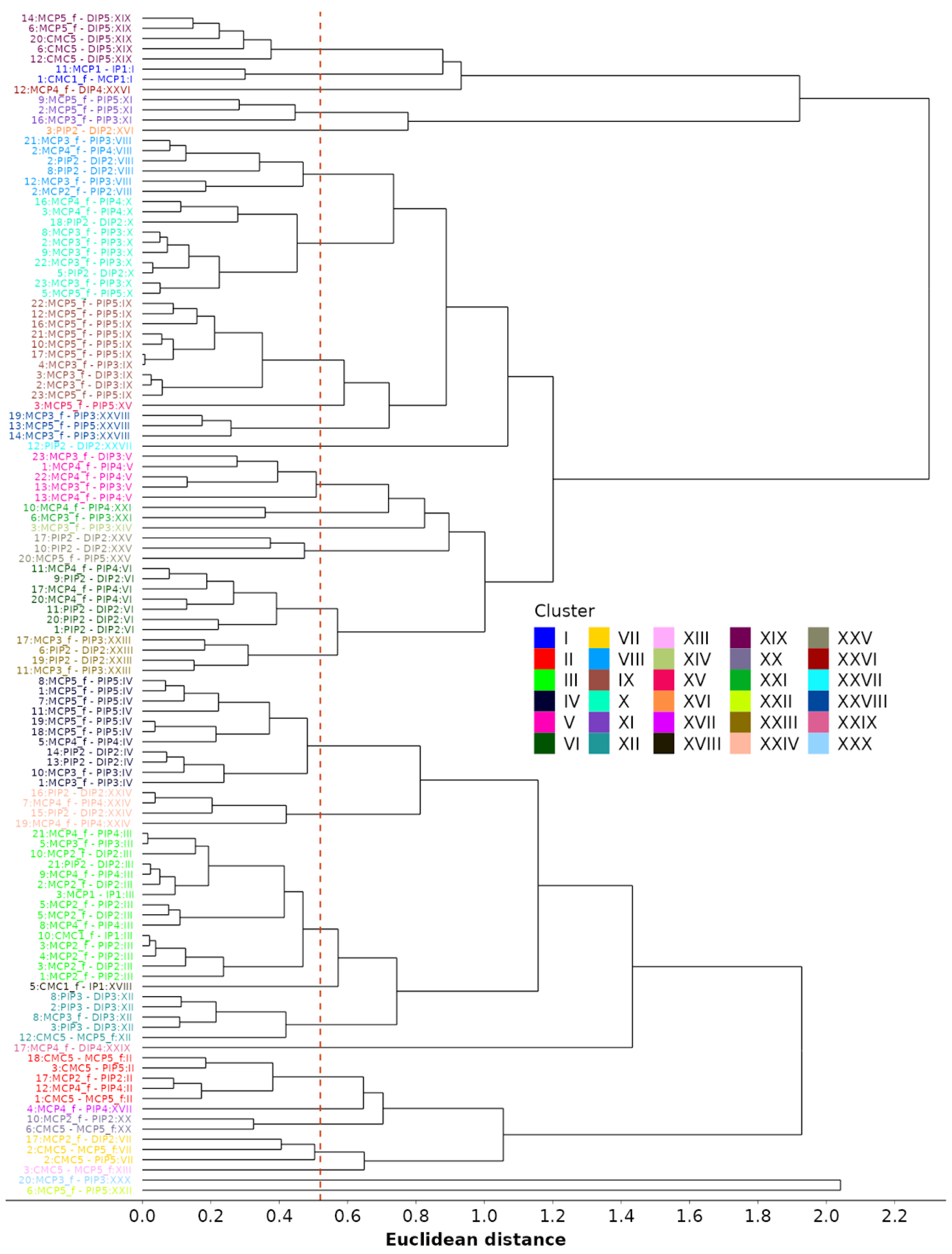

| Subject | Laterality | Gender | Age | Height | Weight | Exercise | Movement | Repetition |
|---|---|---|---|---|---|---|---|---|
| 1–77 | Right Handed, Left Handed | Male, Female | 22–45 | 150–192 | 44–105 | 1, 2 | 1–23 | 1–6 |
| Movement | Joint Angles | Subject | Boxplot Data | ||
|---|---|---|---|---|---|
| 1 | CMC1_f | 1 | n, min, max, mean, median, Q1, Q3, IQR | } | mean IQR, median of medians |
| 1 | CMC1_f | 2 | n, min, max, mean, median, Q1, Q3, IQR | ||
| 1 | … | … | … | ||
| 1 | MCP1 | 1 | n, min, max, mean, median, Q1, Q3, IQR | } | mean IQR, median of medians |
| 1 | MCP1 | 2 | n, min, max, mean, median, Q1, Q3, IQR | ||
| 1 | … | … | … | ||
| 2 | CMC1_f | 1 | n, min, max, mean, median, Q1, Q3, IQR | ||
| … | … | … | … |
| Thumb—Finger 1 [°] | Fingers 2–4 [°] | Finger 5 [°] | |||||||
|---|---|---|---|---|---|---|---|---|---|
| CMC1_f | MCP1 | IP1 | MCP_f | PIP | DIP | CMC5 | MCP5_f | PIP5 | DIP5 |
| −15 ÷ 50 | −40 ÷ 45 | −5 ÷ 75 | −30 ÷ 90 | −5 ÷ 120 | −5 ÷ 90 | 0 ÷ 15 | −30 ÷ 90 | −5 ÷ 135 | −5 ÷ 90 |
| Thumb—Digit 1 | Index—Digit 2 | Middle—Digit 3 | Ring—Digit 4 | Little—Digit 5 |
|---|---|---|---|---|
| MCP1—IP1 CMC1_f—MCP1 CMC1_f—IP1 | MCP2_f—PIP2 MCP2_f—DIP2 PIP2—DIP2 | MCP3_f—DIP3 MCP3_f—PIP3 PIP3—DIP3 | MCP4_f—DIP4 MCP4_f—PIP4 PIP4—DIP4 | CMC5—MCP5_f CMC5—DIP5 CMC5—PIP5 MCP5_f—DIP5 MCP5_f—PIP5 PIP5—DIP5 |
| Movement | 3 | 2 | 1 | 5 | 10 | 12 | 17 | 6 | 8 | 11 | 20 | 9 | 13 | 16 | 19 | 21 | 14 | 23 | 18 | 4 | 22 | 7 | 15 |
| DOFs reduction | 11 | 10 | 7 | 7 | 7 | 7 | 7 | 6 | 6 | 5 | 5 | 4 | 4 | 4 | 4 | 4 | 3 | 3 | 3 | 3 | 3 | 2 | 1 |
| # models per cluster | III × 3 | VII × 2 VIII × 2 | IV × 2 | III × 3 X × 2 | III × 2 | - | - | XIX × 2 | XII × 2 | VI × 2 | VI × 2 | - | V × 2 | - | - | III × 2 | - | - | - | - | - | - | - |
| # reduction models | 9 | 8 | 6 | 4 | 6 | 7 | 7 | 5 | 5 | 4 | 4 | 4 | 3 | 4 | 4 | 3 | 3 | 3 | 3 | 3 | 3 | 2 | 1 |
| DOFs remaining | 5 | 6 | 9 | 9 | 9 | 9 | 9 | 10 | 10 | 11 | 11 | 12 | 12 | 12 | 12 | 12 | 13 | 13 | 13 | 13 | 13 | 14 | 15 |
Disclaimer/Publisher’s Note: The statements, opinions and data contained in all publications are solely those of the individual author(s) and contributor(s) and not of MDPI and/or the editor(s). MDPI and/or the editor(s) disclaim responsibility for any injury to people or property resulting from any ideas, methods, instructions or products referred to in the content. |
© 2024 by the authors. Licensee MDPI, Basel, Switzerland. This article is an open access article distributed under the terms and conditions of the Creative Commons Attribution (CC BY) license (https://creativecommons.org/licenses/by/4.0/).
Share and Cite
Bazina, T.; Mauša, G.; Zelenika, S.; Kamenar, E. Reducing Hand Kinematics by Introducing Grasp-Oriented Intra-Finger Dependencies. Robotics 2024, 13, 82. https://doi.org/10.3390/robotics13060082
Bazina T, Mauša G, Zelenika S, Kamenar E. Reducing Hand Kinematics by Introducing Grasp-Oriented Intra-Finger Dependencies. Robotics. 2024; 13(6):82. https://doi.org/10.3390/robotics13060082
Chicago/Turabian StyleBazina, Tomislav, Goran Mauša, Saša Zelenika, and Ervin Kamenar. 2024. "Reducing Hand Kinematics by Introducing Grasp-Oriented Intra-Finger Dependencies" Robotics 13, no. 6: 82. https://doi.org/10.3390/robotics13060082
APA StyleBazina, T., Mauša, G., Zelenika, S., & Kamenar, E. (2024). Reducing Hand Kinematics by Introducing Grasp-Oriented Intra-Finger Dependencies. Robotics, 13(6), 82. https://doi.org/10.3390/robotics13060082








